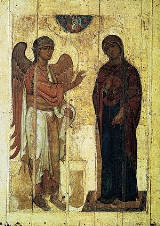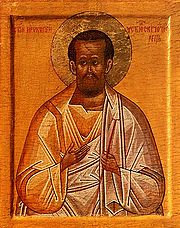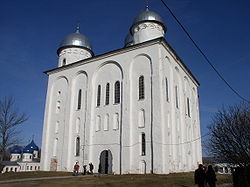
Annunciation of Ustyug
Encyclopedia
Annunciation of Ustyug is a Russian Annunciation
icon
, created in Novgorod
in the 12th century, and one of the few icons, which survived the Mongol invasion of Rus'. The Annunciation of Ustyug is currently held in the Tretyakov Gallery
. The origins of the icon and the exact date of its creation are disputed.
from Saint Sophia Cathedral
to Moscow in the mid 16th century. The exact date of transfer is unknown, as different versions state 1547, 1554 or 1561. At first it was held in Cathedral of the Annunciation
in the Moscow Kremlin
, but in the fore-part of the 17th century was moved to Dormition Cathedral. Circa XVI-XVII it was decorated with gold, gemstone
s and pearl
s. After the shutting of Dormition Cathedral in 1918, Annunciation of Ustyug was taken to the State Historical Museum
. In 1920 scientists started to work on its restoration. In 1930 the museum handed it over to Tretyakov Gallery, where in 1935 restoration was finally finished. It was also restored in the 16th and 17th centuries.
 Annunciation of Ustyug gained its name due to the legend that Saint Procopius of Ustyug
Annunciation of Ustyug gained its name due to the legend that Saint Procopius of Ustyug
predicted the fall of meteorite
near Veliky Ustyug
town. He predicted subsequent storm, tornado
and conflagration
s as well. He tried to convince Veliky Ustyug's citizens to confess their sins
and pray for the city to be saved, but they did not believe him and only in the last minute, when the storm had already started, escaped to the church and started to pray. The whole story was outlined in Life of Procopius of Ustyug , written in the 17th century. A legend, which appeared in 18th century, said that Procopius himself prayed in front of Annunciation to be saved from beating with "stone hail". However no historical confirmation of this event was found. To the contrary, according to the Chronicles of Ustyug, the fire of 1496 destroyed every icon and book inside the church, where the Annunciation was held. Hence it had been burnt down even before Ivan the Terrible was born.
Nevertheless, many authoritative religious figures maintained the legend, connecting the Annunciation with Saint Procopius. In 1747 a copy of the Annunciation was made and solemnly carried to Veliky Ustyug. On July 8 (Julian calendar
) the holiday "A sign from the Annunciation icon in Ustyug town" was established. During the French invasion of Russia
golden decoration and gemstones were stolen, and Veliky Ustyug's citizens donated eight thousand ruble
s to renew the icon.
 Novgorod origin of the Annunciation of Ustyug was first discussed in 1928, although noone showed any proofs of this theory. In 1933 Dmitry Ainalov tried to develop the proof based on the 1554 message of dyak
Novgorod origin of the Annunciation of Ustyug was first discussed in 1928, although noone showed any proofs of this theory. In 1933 Dmitry Ainalov tried to develop the proof based on the 1554 message of dyak
Ivan Viskovatyi
, who mentioned Annunciation icon in connection with Novgorod's Yuriev Monastery
. Finally, Soviet arts critic Viktor Lazarev found a decisive evidence. He compared the proportions of Novgorod's Saint George
icon (created at the same time) with Annunciation of Ustyug and found definite sameness. He also discovered several identical Annunciation icons in the art of Novgorod.
Viktor Lazarev marked the date of creation as 1119—1130, connecting icon's making with the building of St. George's Cathedral in Yuriev Monastery. Macarius I
, dating it the 11th century, supposed that it was created in the year when the Yuriev Monastery itself was built. Some scientists named the earlier dates, yet Galina Kolpakova attributed the Annunciation to 1119—1130 period.
.jpg) Several copies from the original Annunciation were created.
Several copies from the original Annunciation were created.
Annunciation
The Annunciation, also referred to as the Annunciation to the Blessed Virgin Mary or Annunciation of the Lord, is the Christian celebration of the announcement by the angel Gabriel to Virgin Mary, that she would conceive and become the mother of Jesus the Son of God. Gabriel told Mary to name her...
icon
Icon
An icon is a religious work of art, most commonly a painting, from Eastern Christianity and in certain Eastern Catholic churches...
, created in Novgorod
Veliky Novgorod
Veliky Novgorod is one of Russia's most historic cities and the administrative center of Novgorod Oblast. It is situated on the M10 federal highway connecting Moscow and St. Petersburg. The city lies along the Volkhov River just below its outflow from Lake Ilmen...
in the 12th century, and one of the few icons, which survived the Mongol invasion of Rus'. The Annunciation of Ustyug is currently held in the Tretyakov Gallery
Tretyakov Gallery
The State Tretyakov Gallery is an art gallery in Moscow, Russia, the foremost depository of Russian fine art in the world.The gallery's history starts in 1856 when the Moscow merchant Pavel Mikhailovich Tretyakov acquired works by Russian artists of his day with the aim of creating a collection,...
. The origins of the icon and the exact date of its creation are disputed.
History
A history of this icons is known because it was described in several 16th-17th century sources, including the Second Chronicle of Novgorod. The chronicles depict the scene of transferring it by Ivan the TerribleIvan IV of Russia
Ivan IV Vasilyevich , known in English as Ivan the Terrible , was Grand Prince of Moscow from 1533 until his death. His long reign saw the conquest of the Khanates of Kazan, Astrakhan, and Siberia, transforming Russia into a multiethnic and multiconfessional state spanning almost one billion acres,...
from Saint Sophia Cathedral
Saint Sophia Cathedral in Novgorod
The Cathedral of St. Sophia in the Kremlin in Veliky Novgorod is the cathedral church of the Archbishop of Novgorod and the mother church of the Novgorodian Eparchy.-History:...
to Moscow in the mid 16th century. The exact date of transfer is unknown, as different versions state 1547, 1554 or 1561. At first it was held in Cathedral of the Annunciation
Cathedral of the Annunciation
The Cathedral of the Annunciation is a Russian Orthodox church dedicated to the Annunciation of the Theotokos. It is located on the southwest side of Cathedral Square of the Moscow Kremlin in Russia, where it connects directly to the main building of the complex of the Grand Kremlin Palace,...
in the Moscow Kremlin
Moscow Kremlin
The Moscow Kremlin , sometimes referred to as simply The Kremlin, is a historic fortified complex at the heart of Moscow, overlooking the Moskva River , Saint Basil's Cathedral and Red Square and the Alexander Garden...
, but in the fore-part of the 17th century was moved to Dormition Cathedral. Circa XVI-XVII it was decorated with gold, gemstone
Gemstone
A gemstone or gem is a piece of mineral, which, in cut and polished form, is used to make jewelry or other adornments...
s and pearl
Pearl
A pearl is a hard object produced within the soft tissue of a living shelled mollusk. Just like the shell of a mollusk, a pearl is made up of calcium carbonate in minute crystalline form, which has been deposited in concentric layers. The ideal pearl is perfectly round and smooth, but many other...
s. After the shutting of Dormition Cathedral in 1918, Annunciation of Ustyug was taken to the State Historical Museum
State Historical Museum
The State Historical Museum of Russia is a museum of Russian history wedged between Red Square and Manege Square in Moscow. Its exhibitions range from relics of the prehistoric tribes inhabiting present-day Russia, through priceless artworks acquired by members of the Romanov dynasty...
. In 1920 scientists started to work on its restoration. In 1930 the museum handed it over to Tretyakov Gallery, where in 1935 restoration was finally finished. It was also restored in the 16th and 17th centuries.
Name

Procopius of Ustyug
Procopius of Ustyug was a fool for Christ , a miracle worker, saint of Russian Orthodox Church, formerly a merchant from Lübeck. He was born in Germany, a Roman Catholic merchant who converted to eastern Orthodox Christianity during his travels....
predicted the fall of meteorite
Veliky Ustyug (meteorite)
Veliky Ustyug was a meteorite that fell on July 3, 1290 at the Kotovo village near the town of Veliky Ustyug, Vologda Oblast, Russia. The fall was witnessed by local priests. The whole event was later described in the Life of Procopius the Righteous .The meteorite itself has been lost...
near Veliky Ustyug
Veliky Ustyug
Veliky Ustyug is a town in the northeast of Vologda Oblast, Russia, located at the confluence of the Sukhona and Yug Rivers. Administratively, it is incorporated as a town of oblast significance . It also serves as the administrative center of Velikoustyugsky District, by which it is completely...
town. He predicted subsequent storm, tornado
Tornado
A tornado is a violent, dangerous, rotating column of air that is in contact with both the surface of the earth and a cumulonimbus cloud or, in rare cases, the base of a cumulus cloud. They are often referred to as a twister or a cyclone, although the word cyclone is used in meteorology in a wider...
and conflagration
Conflagration
A conflagration or a blaze is an uncontrolled burning that threatens human life, health, or property. A conflagration can be accidentally begun, naturally caused , or intentionally created . Arson can be accomplished for the purpose of sabotage or diversion, and also can be the consequence of...
s as well. He tried to convince Veliky Ustyug's citizens to confess their sins
Confession
This article is for the religious practice of confessing one's sins.Confession is the acknowledgment of sin or wrongs...
and pray for the city to be saved, but they did not believe him and only in the last minute, when the storm had already started, escaped to the church and started to pray. The whole story was outlined in Life of Procopius of Ustyug , written in the 17th century. A legend, which appeared in 18th century, said that Procopius himself prayed in front of Annunciation to be saved from beating with "stone hail". However no historical confirmation of this event was found. To the contrary, according to the Chronicles of Ustyug, the fire of 1496 destroyed every icon and book inside the church, where the Annunciation was held. Hence it had been burnt down even before Ivan the Terrible was born.
Nevertheless, many authoritative religious figures maintained the legend, connecting the Annunciation with Saint Procopius. In 1747 a copy of the Annunciation was made and solemnly carried to Veliky Ustyug. On July 8 (Julian calendar
Julian calendar
The Julian calendar began in 45 BC as a reform of the Roman calendar by Julius Caesar. It was chosen after consultation with the astronomer Sosigenes of Alexandria and was probably designed to approximate the tropical year .The Julian calendar has a regular year of 365 days divided into 12 months...
) the holiday "A sign from the Annunciation icon in Ustyug town" was established. During the French invasion of Russia
French invasion of Russia
The French invasion of Russia of 1812 was a turning point in the Napoleonic Wars. It reduced the French and allied invasion forces to a tiny fraction of their initial strength and triggered a major shift in European politics as it dramatically weakened French hegemony in Europe...
golden decoration and gemstones were stolen, and Veliky Ustyug's citizens donated eight thousand ruble
Ruble
The ruble or rouble is a unit of currency. Currently, the currency units of Belarus, Russia, Abkhazia, South Ossetia and Transnistria, and, in the past, the currency units of several other countries, notably countries influenced by Russia and the Soviet Union, are named rubles, though they all are...
s to renew the icon.
Origin and dating

Dyak (clerk)
Dyak is a historical Russian bureaucratic occupation whose meaning varied over time and approximately corresponded to the notions of "chief clerk" or "chief of office department"....
Ivan Viskovatyi
Ivan Mikhailovich Viskovatyi
Ivan Mikhailovich Viskovatiy was a Russian diplomat and head of the Posolsky Prikaz ....
, who mentioned Annunciation icon in connection with Novgorod's Yuriev Monastery
Yuriev Monastery
The St. George's Monastery is one of Russia's oldest monasteries. It stands south of Novgorod on the left bank of the Volkhov River near where it flows out of Lake Ilmen. The monastery used to be the most important in the medieval Novgorod Republic...
. Finally, Soviet arts critic Viktor Lazarev found a decisive evidence. He compared the proportions of Novgorod's Saint George
Saint George
Saint George was, according to tradition, a Roman soldier from Syria Palaestina and a priest in the Guard of Diocletian, who is venerated as a Christian martyr. In hagiography Saint George is one of the most venerated saints in the Catholic , Anglican, Eastern Orthodox, and the Oriental Orthodox...
icon (created at the same time) with Annunciation of Ustyug and found definite sameness. He also discovered several identical Annunciation icons in the art of Novgorod.
Viktor Lazarev marked the date of creation as 1119—1130, connecting icon's making with the building of St. George's Cathedral in Yuriev Monastery. Macarius I
Macarius I
Macarius I , born Mikhail Petrovich Bulgakov , was the Metropolitan of Moscow and Kolomna in 1879-1882 and member of many learned societies, including the Russian Academy of Sciences....
, dating it the 11th century, supposed that it was created in the year when the Yuriev Monastery itself was built. Some scientists named the earlier dates, yet Galina Kolpakova attributed the Annunciation to 1119—1130 period.
Copies
.jpg)
- for Cathedral of the ArchangelCathedral of the ArchangelThe Cathedral of the Archangel is a Russian Orthodox church dedicated to the Archangel Michael. It is located in Cathedral Square of the Moscow Kremlin in Russia between the Great Kremlin Palace and the Ivan the Great Bell Tower. It was the main necropolis for members of the Tsars of Russia until...
, painted in the 16th century. Considered to be the closest to the original. - for Troitse-Sergiyeva LavraTroitse-Sergiyeva LavraThe Trinity Lavra of St. Sergius is the most important Russian monastery and the spiritual centre of the Russian Orthodox Church. The monastery is situated in the town of Sergiyev Posad, about 70 km to the north-east from Moscow by the road leading to Yaroslavl, and currently is home to...
, painted in the 16th century. - for Cathedral of the Annunciation in Moscow Kremlin, painted in the 17th century.
- for Novodevichy ConventNovodevichy ConventNovodevichy Convent, also known as Bogoroditse-Smolensky Monastery is probably the best-known cloister of Moscow. Its name, sometimes translated as the New Maidens' Monastery, was devised to differ from an ancient maidens' convent within the Moscow Kremlin. Unlike other Moscow cloisters, it has...
. - for Solovetsky MonasterySolovetsky MonasterySolovetsky Monastery was the greatest citadel of Christianity in the Russian North before being turned into a special Soviet prison and labor camp , which served as a prototype for the GULag system. Situated on the Solovetsky Islands in the White Sea, the monastery braved many changes of fortune...
, painted in the 16th-17th centuries.

